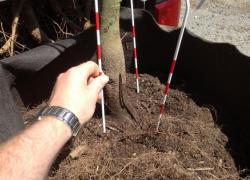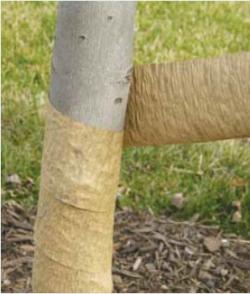With the summer solstice nearly upon us, community tree planting efforts are unfolding all over the Northeast. And though we may all have our “own way” of doing things, what do the experts from academia and industry tell us about correct planting? The Best Management Practice (BMP) companion publications are developed by the International Society of Arboriculture (ISA) for application by arborists and urban forestry practitioners to aid in the “interpretation of the professional standards and to guide work practices based on current science and technology.” The recently updated second edition of Tree Planting by Gary Watson, Ph.D. (2014) was developed as a complement to the ANSI A300 (Part 6) Tree, Shrub, and other Woody Plant Maintenance – Standard Practices (Planting and Transplanting), by the Tree Care Industry Association (TCIA).
 This newly-revised planting guide is divided into eight parts. It begins by introducing the notion that we plant trees for their long-term benefits, and while proper plant selection and other sound practices are important, a poorly prepared site and improperly installed tree may “never reach its full potential as a healthy, vigorous addition to the landscape.”
This newly-revised planting guide is divided into eight parts. It begins by introducing the notion that we plant trees for their long-term benefits, and while proper plant selection and other sound practices are important, a poorly prepared site and improperly installed tree may “never reach its full potential as a healthy, vigorous addition to the landscape.”
Part one outlines the ‘Time of Planting’ and identifies that in a temperate zone, the preferred season of planting is typically autumn or spring, but that trees are routinely installed throughout the year, when soils are not frozen. Two species – magnolia (Magnolia spp.) and oak (Quercus spp.) are identified as often being difficult to successfully establish if they are planted in the fall.
Part two discusses the ‘Selection of Nursery Stock’ and commences by outlining the importance of selecting locally-grown trees, as they will be most compatible with local climactic conditions. This section is further sub-divided into nursery production systems, identifying the strengths and weaknesses of utilizing ‘bare-root’ (BR), ‘balled-and-burlapped’ (B&B), ‘in-ground fabric’ (IGF), and ‘container-grown’ trees.
Indicative of its importance in the landscape, part three is entirely dedicated to ‘Proper Root Depth.’ Excess soil on top of the roots in tree installations in the landscape is all-too-often observed in urban settings, regardless of production method. The section commences by highlighting that a swelling should be notable at the base of the trunk (i.e., the ‘flare’), with three or four main flare roots being necessary for tree stability. The guide goes on to encourage removal of excess soil from over the root system and the measuring of the remaining root-ball to determine if root-ball depth measurements meet standards and do not warrant rejecting the tree. According to the guide, excess soil levels are ideally removed before trees are dug in the nursery, as it is often more difficult to address the issue when trees arrive on the job site when there can be increased resistance to replacing the stock after delivery. This section closes by encouraging a thorough examination of trees to determine if there is an excessive soil issue, including noting a space or gap around the lower portion of the stem, by looking for graft unions, and by searching for main roots with chaining pins.
 Part four, ‘Handling & Storage’, begins by highlighting the importance of lifting the tree by the root ball or container for all but small trees, and protecting the stem with the use of a proper sling or padding, should it be used to support the tree during transport. While plants are being moved, the branches should be tied, wrapped in a tarp, and kept wet – especially if several days are expected before final delivery. Steps for proper storage are also outlined after trees are delivered, including the use of mulch, wraps, and irrigation to keep plant roots moist.
Part four, ‘Handling & Storage’, begins by highlighting the importance of lifting the tree by the root ball or container for all but small trees, and protecting the stem with the use of a proper sling or padding, should it be used to support the tree during transport. While plants are being moved, the branches should be tied, wrapped in a tarp, and kept wet – especially if several days are expected before final delivery. Steps for proper storage are also outlined after trees are delivered, including the use of mulch, wraps, and irrigation to keep plant roots moist.
The heart of this guide, the ‘Planting’ section (part five), is the largest component of this manual. It reiterates that this stage really commences with a site condition evaluation and finishes with after care. To determine the drainage rate of a potential planting site, details about a properly performed percolation (also called “perc”) test are discussed, and a drainage rate of less than one-quarter inch per hour are identified as being potentially problematic, requiring steps to increase drainage. To determine soil nutrient, organic matter (OM), and pH levels, a soil nutrient analysis is encouraged, with the idea that urban foresters may be able to properly select plant material that will be compatible with site conditions. Amending the site with composted OM is highlighted as being a strategy to improve drainage, improve the percentage of nutrients, change pH, and aid in long-term performance of the tree. Fertilizers should only be applied in accordance with known soil deficiencies.
 Part five continues with discussion about the bottom of the trunk flare (the area of transition between the root system and the trunk) being located at or above the finished grade. Instructions are detailed about addressing excess soil on roots, by encouraging that a hole be dug shallow enough to compensate for the removal of excess soil above the large buttress or flare roots (perhaps up to 2” shallower than the root ball depth or 2.5” shallower than the container depth). Professionals are cautioned that if these large roots are planted too deeply, this problem can be difficult to correct. Planting hole width recommendations on sites with high-quality soil are defined as needing to be only wide enough to facilitate planting; sites with poorer quality soil, may require wider holes at least two times the width of the root ball diameter. If holes are dug and glazing or drying/crusting of the sides takes place, the use of a hand tool to break up these surfaces is recommended to facilitate root establishment.
Part five continues with discussion about the bottom of the trunk flare (the area of transition between the root system and the trunk) being located at or above the finished grade. Instructions are detailed about addressing excess soil on roots, by encouraging that a hole be dug shallow enough to compensate for the removal of excess soil above the large buttress or flare roots (perhaps up to 2” shallower than the root ball depth or 2.5” shallower than the container depth). Professionals are cautioned that if these large roots are planted too deeply, this problem can be difficult to correct. Planting hole width recommendations on sites with high-quality soil are defined as needing to be only wide enough to facilitate planting; sites with poorer quality soil, may require wider holes at least two times the width of the root ball diameter. If holes are dug and glazing or drying/crusting of the sides takes place, the use of a hand tool to break up these surfaces is recommended to facilitate root establishment.
Within part five, the section on ‘Preparing the Root Ball for Planting’ outlines procedures for final preparation of the trees before they are planted, including trees produced using IGF, trees produced bare-root, and field-grown trees (B&B). The guide asserts that the entire grow bag should be removed from trees that are produced IGF, and that excess materials like hydrogel, should be shaken from bare-root trees. This guide recommends removal of synthetic burlap from B&B trees before they are actually installed; the upper one-quarter to one-third of the wire basket and natural burlap are recommended for removal. This has created some discussion in the industry with professionals questioning why this BMP stops short of recommending that the entire basket and burlap be removed. Once the tree is placed in the ground, it is recommended that soil be replaced six inches at a time and be watered or lightly tamped in. Mulch applied that does not contact the bark of the newly-planted tree, to a depth of two inches and a diameter of six to nine feet for a new tree, is encouraged as it can improve growth and establishment, help to preclude weeds, moderate soil temperatures, and replace organic matter. Though trunk wraps are not expressly recommended, they are discussed related to protecting bark from winter sun. Interestingly, itis suggested that maintaining similar directional orientation in the new site as was in the nursery may aid in preventing sun-related injury to the stem. This section closes with discussion pertaining to the use of plastic guards to preclude animal injury, as well as discussion about proper planting of palm trees.
 Part six, ‘Establishment After Planting’, details the needs that trees have once they are installed. Regardless of production method, newly-planted trees may experience water stress and that the most reliable technique to encourage new root development is to manage moisture and aeration and provide a high-quality soil environment for root development. Soil compaction and soil temperatures are listed as being variables important to root growth; stimulants that claim to influence root growth are considered inconsistent based on research results.
Part six, ‘Establishment After Planting’, details the needs that trees have once they are installed. Regardless of production method, newly-planted trees may experience water stress and that the most reliable technique to encourage new root development is to manage moisture and aeration and provide a high-quality soil environment for root development. Soil compaction and soil temperatures are listed as being variables important to root growth; stimulants that claim to influence root growth are considered inconsistent based on research results.
Part seven, ‘Maintenance During Establishment’, details the importance of ensuring that the root ball should be kept moist for the first year or two after planting and that water may need to be administered twice-weekly, so that the tree gets about 10 gallons per caliper inch per week in hot weather. Cautionary information is included about how standard irrigation systems for lawns often over-irrigate trees, and professionals are encouraged to routinely check the state of moisture in the root ball with a rod or tensiometer. The guide continues to the ‘Fertilization’ section, where it indicates that “adding fertilizer at planting is not usually effective in speeding establishment.” Several select situations are discussed where a slow-release fertilizer application may be warranted or helpful; however, the guide re-iterates that products should be applied to correct demonstrated deficiencies.
Though the guide closes this section with discussion about the possible benefit of anti-transpirants and pesticide applications as part of a pest management program for newly-planted trees, preventing problems associated with transplanting and pests through proper cultural practices seem to be the underlying theme. Selective removal of branches to improve structure of newly-planted trees is outlined, with the thought that returning to prune trees in ensuing years will be necessary.
Part eight, ‘Inspection’, is the final section and it indicates that each step of the process should be as closely monitored as possible, from the digging of the hole to the inspection of plant material, to after-care of the newly installed tree.
For more information more about the BMP companion guides, visit: www.isa-arbor.com
- Rick Harper, Extension Assistant Professor, University of Massachusetts Department of Environmental Conservation
